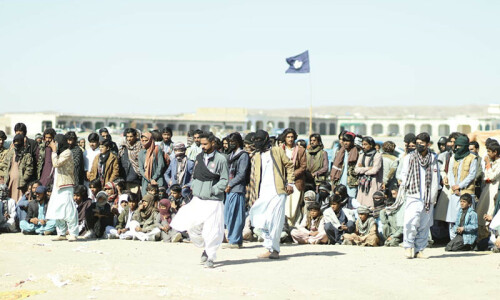Looking to the stars
Published
April 16, 2014











































The Karachi Astronomers Society are an astronomical society formed between 2008 and 2009, based in Karachi and run completely by enthusiasts. Its aim is to promote astronomy and to bring it back from its relative obscurity in the country. The society has over 1000 members; most of whom very actively promote and pursue astronomy within their own means. It also owns some of Pakistan's largest and most advanced telescopes; which are used on their monthly astronomy trips to different locations near Karachi, as well as in their public sessions.
Read more
On DawnNews
Comments (13) Closed
Muhammad Atif
Apr 17, 2014 12:31am
Beautiful images.
Recommend
0
Nasir Khan
Apr 17, 2014 02:07am
Love to see all these people out there in pursuit of something educational and aesthetic. Kind of make you wonder how small human being is and how short this life is, why make a fuss?
Recommend
0
Ashher
Apr 17, 2014 05:42am
Lovely pcitures, welldone to Karachi Astronomers Society. I am far away from home land and very excited to go on a star gazzing trip this weekend
Recommend
0
Indian
Apr 17, 2014 09:31am
Oh my God!! Such beauuutiful images... :)
Recommend
0
RM
Apr 17, 2014 10:19am
Apart from some really beautiful pictures, it good to know such society exists here in Karachi. It will definitely promote astronomy in generations to come. Keep the good work!
Recommend
0
Adil
Apr 17, 2014 11:20am
There is a lot of difference between astronomers and a bunch of guys taking pictures of the night sky!
Recommend
0
Aman
Apr 17, 2014 02:04pm
Wonderful to see this. This is what I want..Keep it up (May Pakistan be 1st in science and logic and last in fundamentalism)..once in my life, I want to visit Takshilla and Indus civilization and eat some of the best kebabs in Lahore freely as a Hindu with pack of Pakistani friends. I hope that day is coming...
Recommend
0
Ramiz
Apr 17, 2014 04:19pm
@Adil:
True. If you go to our FB page you'd come to know of our public presentations, workshops, telescopic viewing sessions and educational blogs as well. You're welcome to participate in them.
Recommend
0
chikoo
Apr 17, 2014 06:08pm
Oh my days!! i am really really honored to say you people , you have carried out such a fabulous job. snaps really got my all attention to them seriously amazing keep it up, hey guys can i follow your pages on facebook ?
Recommend
0
Sarthak
Apr 18, 2014 11:50am
@Ramiz:
You are doing something nice and important. Keep it up. The pics are awesome.
Recommend
0
Ramiz
Apr 18, 2014 03:17pm
@Sarthak:
Thank you Sarthak but it's the whole society. Just regular folks who're putting in effort to take astronomy to the heights it deserves to be at :)
Recommend
0
Zain Ahmed
Apr 18, 2014 06:29pm
@chikoo:
You sure can:
facebook.com/SahalTelescopes, facebook.com/KarachiAstronomy, facebook.com/KaAStrodome and facebook.com/groups/LahoreAstronomy
Recommend
0
talha
Apr 19, 2014 10:23am
i wanst expecting this was from Pakistan superb and brillant effort by astros
Recommend
0
Read All Comments

















































